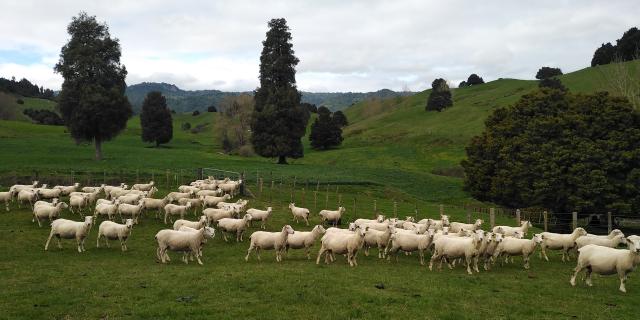It’s commonly accepted that ewes lose some immunity to internal parasites over lambing.

This can be measured as an increase in Faecal Egg Counts (FEC), commonly termed the PPR (Peri-Parturient Rise), which may start around 2 weeks prior to lambing. In mature crossbred ewes, FECs are often declining again by docking/tailing; in younger ewes and fine wool breeds it can continue for longer.
The PPR does not occur in all ewes, all mobs, or on all farms, and the consequences of it are highly variable and very dependent on the farm system.
So, what factors drive this rise in egg counts, does it matter and how should we monitor and manage it?
Why does the PPR happen?
The last few weeks of pregnancy see our ewes undergoing big changes in metabolism and energy partitioning, plus fluctuations in hormones that drive the production of colostrum in the udder and maintain pregnancy in the final weeks. Changes in these have been well documented and seems likely that parasite immunity drops down the priority list in some ewes.
There’s plenty of research to show that ewes that are better fed (especially those fed high quality protein as well as adequate energy) have lower FECs over lambing than poorly or ‘averagely’ fed ewes, and ewes from genetic lines that are resistant to parasites also have a substantially lower PPR. There is also some evidence that genetically resistant ewes produce eggs with a lower rate of hatching and development in the environment, an added benefit in reducing the next generation of worms on pasture.
Does the PPR matter?
A quick browse of the internet will yield multiple articles that highlight the PPR as a major source of worm challenge to the new season’s lambs.
At the farm level, the drivers of parasite challenge to these lambs are far more nuanced.
The rise in worm larvae on pasture in spring is caused by a combination of the PPR and infection of young lambs from larvae that have survived the winter on pasture. As our winters have warmed up, conditions favour ongoing cycling of worms on pasture – there are more days where temperatures favour egg hatching and larval development. The impact of autumn worm contamination was always a handbrake on sheep performance, now this is being magnified by changing environmental conditions.
In systems where ewes lamb down on permanent pasture that predominantly grazed lambs the previous autumn, much of the worm contamination will be larvae that have overwintered from the autumn worm load set up by the previous season’s lambs.
In studies that have looked at the contribution of the PPR to worm larvae on pasture, the peak of larvae caused by the ewes is small in comparison to the autumn peak caused by lambs. In the multi-year AgResearch studies at Flock House where capsule use was established as a risk factor for drench resistance, the PPR in ewes only contributed to measurable levels of infection in lambs one year in three.
Where this spring rise in ewe egg output takes place on top of already elevated pasture larval levels, it can tip the balance and create worm issues for both the ewes and their lambs. Especially under conditions of poor nutrition and sub-optimal ewe condition.
Where failing drenches in autumn have set up a population of drench resistant larvae on pasture, the situation becomes even more challenging as the traditional pre-lamb treatments that may have been given to ewes, lose their efficacy.
What should we do about the PPR?
How important the PPR is, depends very much on the individual farm system.
In situations where ewes are in optimal body condition, lambing down on good feed covers at a time of year where pasture is growing to meet demand, elevated FECs in ewes over lambing may have very little consequence. If large numbers of lambs have not been carried on these areas over the autumn, so much the better.
This is evident on breeding farms in every district where ewe performance is a priority – this starts the day that lambs are weaned in the previous season. Those targets for ewe condition and feed supply for lambing are major drivers of decisions from New Year’s day onwards. Worm-resistant sheep genetics add to the recipe here, because these ewes have lower FECs over lambing. But simply relying on genetics to do the job will not be successful if feeding and body condition targets are not met.
Faecal egg counts are a useful tool in ewes at this time to see what is going on but are only part of the picture.
For example, in areas affected by autumn drought, poor ewe condition and low feed levels are likely to increase pressure from parasites. In this situation, a decision about pre-lamb treatment of ewes should be driven by these aspects. Not treating on the basis of a low FEC pre-lamb for ewes in poor condition and on short feed could be the wrong move.
Long-acting treatments given in this situation are more likely to give production responses than short-acting ones. Extra ewe & lamb weaning weight are economically important outcomes that have been measured from long-acting treatment of ewes under feed pressure. There is no evidence that these products improve lamb survival. Whether these products are still effective on your farm and how many resistant worms they contribute to the next season’s parasite load are separate questions.
Short-acting products may give the ewe a temporary clean-out, but limited work tracking these sheep shows they can become re-infected while they’re still in that period of relaxed immunity, and there is no modern data that show production benefits from such treatment.
If poor ewe condition and low feed levels are a perennial issue at lambing time, the discussion should centre on how to fix these underlying issues, rather than what product to treat the ewes with.
Other reading
Read this article providing advice on pre-weaning lamb management and factors to consider before giving a pre-weaning drench.